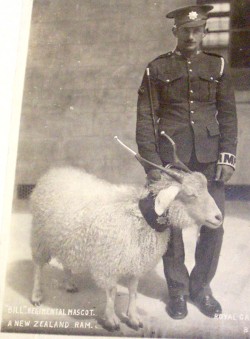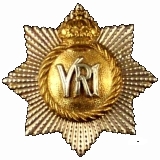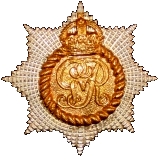
The Royal Canadian Regiment and
The First World War - 1914-1919
A Regimental Goat
By: Captain Michael M. O'Leary, orginally published in the regimental journal of The Royal Canadian Regiment, PRO PATRIA 2007
We've all heard of Bâtisse, the regimental goat of le Royal 22e Régiment. The Van Doos are currently tending to Bâtisse X, which will no doubt some day be replaced by Bâtisse XI. But few Royal Canadians are aware that even before Bâtisse (zero) first joined notre soeur Régiment on parade, our very own Regiment was appointing regimental goat-keepers from among the Band's drummers.

"Bill", a New Zealand ram adopted by The RCR as a regimental mascot on taking over garrison duties in Bermuda from the 2nd Bn, Lincolnshire Regiment.
Even before the 22nd Canadian Infantry Battalion (later to be perpetuated by the R 22eR) were just starting to learn their gauche from their droit on a Valcartier drill square, The RCR were being called upon to be the first Canadians overseas (if not, perhaps, the first in the field, an honour which falls to the Princess Patricia's Canadian Light Infantry). In the fall of 1914, The RCR was despatched to Bermuda to serve as a garrison battalion, relieving the 2nd Battalion, Lincolnshire Regiment.
Among the garrison battalion's effects to be signed for, probably listed somewhere between "cats, nine-tailed" and "kegs, rum, empty" was apparently listed "goat, regimental, unit of issue 1, with EIS". And so, following signatures of RQMS' and COs', in triplicate as required by KR&O, the regimental establishment was increased "goat x 1". Bill the mascot was, more specifically, a New Zealand ram and he was duly badged into The Royal Canadian Regiment. Responsibilities for animal husbandry then needed to be met and so, three Drummers were duly appointed to handle the dietary and excretory requirements of this humble animal.
3587 Boy Albert James Healey turned 15 years of age while serving with the Regiment in Bermuda. Healey had been on the regimental strength as a Boy Drummer since his thirteenth birthday in December 1913, enrolling at Quebec City. Standing tall at 4 feet 11 inches in height, he later attested for overseas service in Europe with The RCR, being given the regimental number 477390.
9813 Boy Gerald Cameron was taken on the strength of The RCR at Halifax in July 1914. He was seventeen years of age when he arrived in Bermuda and later attested for overseas service with The RCR, being given the new regimental number 477140.
9588 Boy William "Bogo" Tanner was a "seasoned soldier" among the drummers and the son of a regimental soldier. Tanner joined The RCR in February 1912 at the Halifax Garrison. In late 1915 he attested for overseas service with the rest of the Regiment and was given the regimental number 477913. Tanner was 17 years old when he was attested for overseas service and given the regimental number 477913.
From the May 1971 Pro Patria, we know the following about our regimental goat from 477869 Pte Dudley Douglas Spencer:
After about 3 months, we had to change our Canadian money into Pounds, Shillings and Pence. Our Colour Sgt "Mutiny Morash" smoked Polo Cigarette Tobacco at 5 cents a package which rolled 43 cigarettes. He had run short and went to buy more at the dry canteen, whilst he was away, his office window was open, and said goat ambling around getting dried after a bath, saw the Canadian bills and devoured the lot so the story goes. He reported the loss to his Commanding Officer, who promptly ordered a Court of Inquiry as to where the money went. The poor goat was blamed for the $500.00 loss. The Inquiry Board was baffled if they, gave the goat an emetic, (it may cause vomiting and perhaps cough up the dough) but we had no Vet or Animal Doctor to give it, so the poor goat was impounded for 3 days and all of its dung was examined closely for trace of paper from its stomach but the Pioneer Sgt found nothing which would say "Pay to the Bearer on Demand". The Court gave Colour Sgt Morash the benefit of the doubt and it's still a mystery where that money went. Had he been found guilty, he may have looked into "The Old Testament", where the Dietary Laws say that only animals with the cloven hoof shall be eaten (the Goat has a cloven hoof).
And so, in 1915, The RCR was the first Canadian Regular Force infantry regiment to parade with a goat as mascot. We have no clear record of its status at the end of our time in Bermuda when we handed over the garrison duties to the 38th Canadian Infantry Battalion, which relieved us on the island. We can assume it was transferred as garrison stores once more, along with the remaining "cats, nine-tailed" and probably a slightly increased stock of "kegs, rum, empty".
Pro Patria
- The O'Leary Collection; Medals of The Royal Canadian Regiment.
- Researching Canadian Soldiers of the First World War
- Researching The Royal Canadian Regiment
- The RCR in the First World War
- Badges of The RCR
- The Senior Subaltern
- The Minute Book (blog)
- Rogue Papers
- Tactical Primers
- The Regimental Library
- Battle Honours
- Perpetuation of the CEF
- A Miscellany
- Quotes
- The Frontenac Times
- Site Map

![]() The RCR in the Great War
The RCR in the Great War
![]() War Diary
War Diary
![]() Battle Honours
Battle Honours
![]() Battle Bars and The RCR
Battle Bars and The RCR
![]() The RCR Battle Bar Ledger (pdf)
The RCR Battle Bar Ledger (pdf)
![]() Honours and Awards
Honours and Awards
![]() Roll of Honour
Roll of Honour
![]() Prisoners of War
Prisoners of War
![]() Cemetery List
Cemetery List
![]() Cemetery Map
Cemetery Map
![]() Courts Martial
Courts Martial
![]() Officers
Officers
![]() RSMs of The RCR (1914-1919)
RSMs of The RCR (1914-1919)
![]() NCOs and Soldiers
NCOs and Soldiers
![]() An Officer's Diary (1914-1918)
An Officer's Diary (1914-1918)
![]() Recollections of a Nonagenerian (R. England) (1916-1919)
Recollections of a Nonagenerian (R. England) (1916-1919)
![]() On to Bermuda (1914-15)
On to Bermuda (1914-15)
![]() England and France 1915-1916 (Hayes; 1931)
England and France 1915-1916 (Hayes; 1931)
![]() Overseas with The Royals (1915)
Overseas with The Royals (1915)
![]() Regimental History Pamphlet (1917)
Regimental History Pamphlet (1917)
![]() Amiens (1918)
Amiens (1918)
![]() Cambrai (1918)
Cambrai (1918)
![]() Monchy-le-Preux (1918)
Monchy-le-Preux (1918)
![]() Under-aged Soldiers in The RCR
Under-aged Soldiers in The RCR
![]() Not All Were Volunteers; The RCR and the Military Service Act
Not All Were Volunteers; The RCR and the Military Service Act
![]() Sentenced to Death by Court Martial
Sentenced to Death by Court Martial
![]() The 7th Trench Mortar Battery
The 7th Trench Mortar Battery
![]() A Regimental Goat
A Regimental Goat
![]() Regiment and Family, Bermuda 1914-15
Regiment and Family, Bermuda 1914-15
![]() "March the Guilty Bastard In"
"March the Guilty Bastard In"
![]() Surrendered as Stowaway
Surrendered as Stowaway
![]() Re-Visiting the Great War Roll of Honour for The RCR
Re-Visiting the Great War Roll of Honour for The RCR
![]() Canadian Corps Trench Standing Orders (1916)
Canadian Corps Trench Standing Orders (1916)

